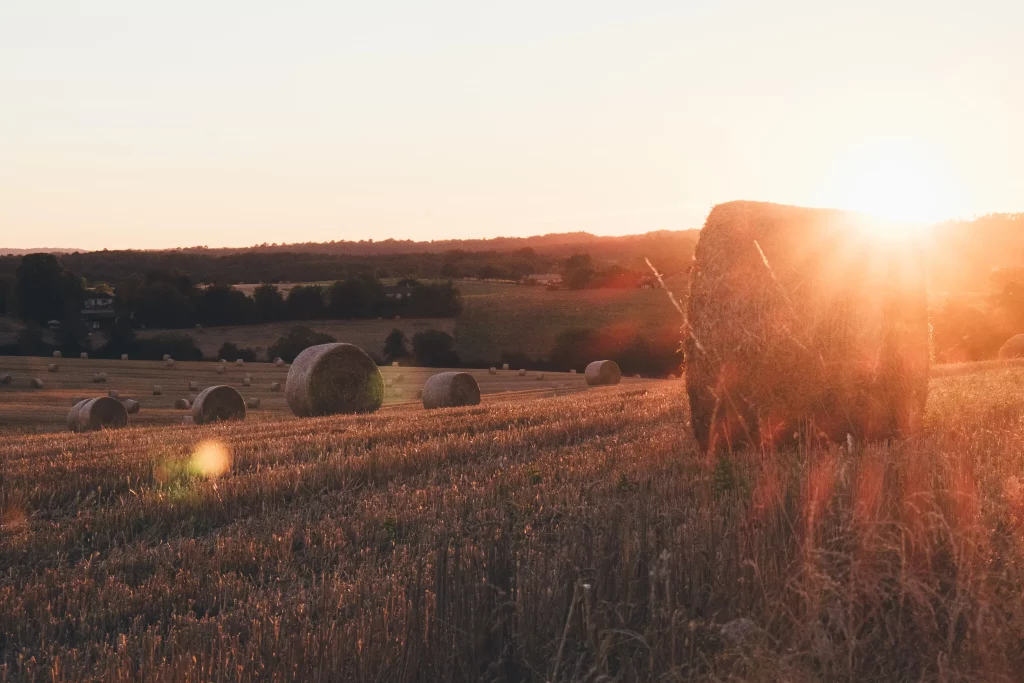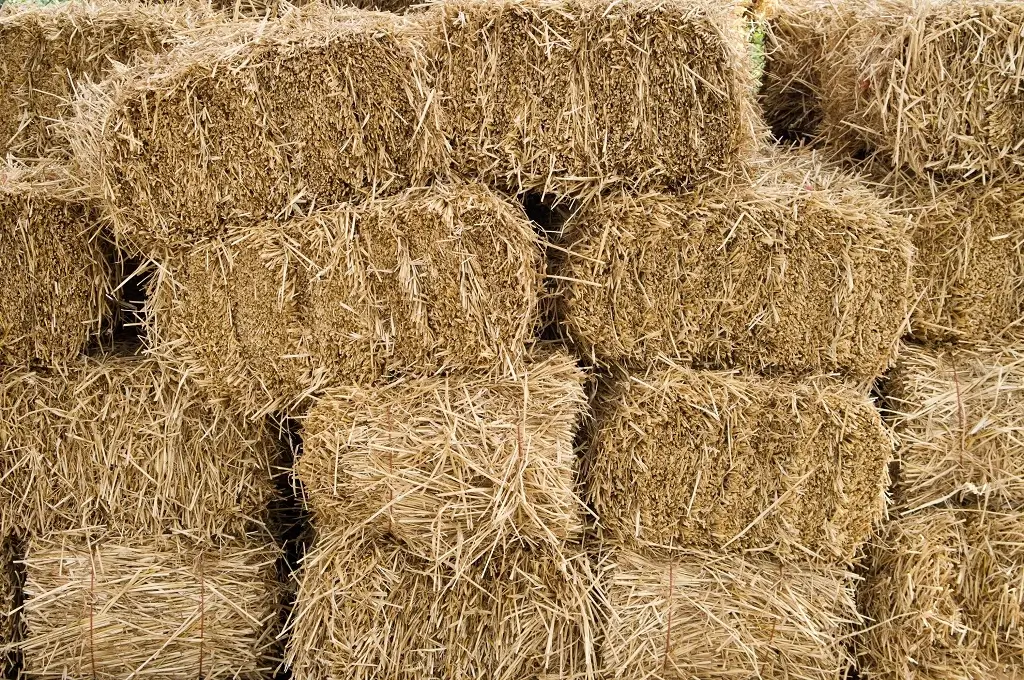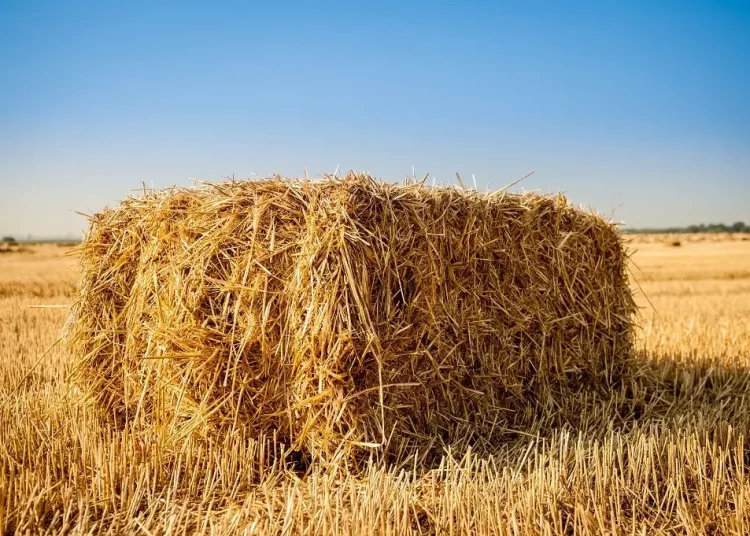Hay is very important for ranchers who need to keep up with the demands of their livestock. Animals such as cows, sheep, goats, and horses can use hay as a food source. It can even be used by people who are raising rabbits or guinea pigs. Its composition can also vary depending on the farm or region.
Hay is typically made up of dried grass but can also be made up of legumes. Some farmers will also use herbaceous plants to make hay. So that it can be used as fodder, it has to be cut, dried, and stored properly. Variables in the type of plant used and its processing affect the bale’s weight.
Knowing the weight of the hay bale is very important, especially for farmers who want to ensure they have the right amount in store for the winter. Besides, hay balers can pack the bale of hay they produce as tightly or loosely as they want. Here are some information you might find useful.
How Much Does An Average Bale Of Hay Weigh?

Rectangular bales of hay are either classified as 2-stringed or 3-stringed. 2-stringed bales are typically 36 inches long, 19 inches wide, and 16 inches tall. These typically weigh anywhere between 40 – 75 pounds. 2-stringed bales are harder to find but easier to work with as a single person can handle them.
A 3-stringed bale, on the other hand, is 44 inches in length, 22 inches in width, and 15 inches in height. This type of rectangular bale typically weighs 100 – 140 pounds. These are much larger and heavier, requiring at least two persons to handle. These bales, however, are solid and sturdy when stacked.
You can also buy one-ton or half-ton bales of hay. One-ton bales are 8 feet by 4 feet by 4 feet. These can weigh as much as 2,000 pounds. On the other hand, half-ton bales are 6 feet by 4 feet by 3 feet and are around 1000 pounds. That said, making all bales of uniform weight is very difficult.
This is because balers or the machines that pack the hay into bales do the task without much regard for the weight. Instead, it aims to pack them in the right dimensions. You should also know that the amount of moisture in each hay bale will have a significant impact on its final weight.
Balers that make rectangular hay bales will use twine knotted to secure the hay. Since they are highly compacted, they are known to weigh more than round bales of hay. Although they can be easily piled on top of each other for storage, feeding them to livestock is labor intensive.
You might be interested: Spring into Gardening: How to Start a Garden for Beginners
How Much Does A Round Bale Of Hay Weigh?
Aside from rectangular bales of hay, some machines can make round bales. Many farmers use it because feeding their livestock with round bales is much easier than rectangular ones. The round bales, however, are more difficult to stack simply because it does not have much stability.
Round bales are also quite hard to transport because they tend to roll around, especially when using flatbed trucks. As with the rectangular bales of hay, getting a uniform weight can be very hard. Most farmers will just say that their round bales weigh 1000 lbs.
So you can have a better idea about how each of them will weigh, you should know that a small round bale that is 4 feet in width and 4 feet in height will weigh around 400 – 600 pounds. A medium-sized bale 5 feet in width and 4.5 feet in height will weigh around 720 – 950 pounds.
On the other hand, a large round bale that is 5 feet in width and 6 feet in height will weigh around 1270 – 1700 pounds. Of course, the only way to determine the exact weight is to use a weighing scale. But with the help of these estimates, you can closely guess how much an entire lot will weigh.
How Moisture Affects the Weight of a Hay Bales
Moisture plays an essential role in determining the weight of a hay bale. When hay is baled at a higher moisture content, it tends to be heavier. However, it’s important to understand that while a heavier bale might seem better, excessive moisture can lead to mold growth, compromising the hay quality.
You might be interested: Landscaping Without Breaking the Bank
Importance of Dry Hay for Animal Health

Dry hay is not just a preference. It’s a necessity for the health and well-being of your livestock. Damp hay can become a breeding ground for mold and bacteria, which can be harmful if ingested by animals.
Consuming moldy hay can lead to respiratory, digestive, and other health complications in livestock. Therefore, ensuring your hay is adequately dried before baling and storage is crucial for the safety and health of your animals.
You might be interested: A DIY Landscaping Project With No Tools Required
Tips for Properly Storing Hay Bales

Proper storage of hay bales is paramount not only to maintain their quality but also to ensure the health and well-being of the livestock that consume them. Here are some essential guidelines to consider:
- Protection from Moisture: Moisture is the enemy when it comes to hay storage. Wet hay can lead to mold growth, which can be harmful when ingested by animals. Always store hay in a dry place and elevate it off the ground to prevent moisture absorption. Using pallets or a layer of gravel can be effective.
- Shield from Direct Sunlight: While hay needs to be dried before storage, prolonged exposure to direct sunlight can degrade its nutritional value. A shaded area or a barn is ideal for storage.
- Adequate Ventilation: While you want to keep moisture out, ensuring the storage area is well-ventilated is essential. This helps prevent the buildup of heat and moisture, leading to spontaneous combustion.
- Guard Against Pests: Rodents and pests can contaminate hay, making it unsafe for consumption. Regularly inspect your storage area for signs of infestation, and consider using natural repellents or barriers.
- Regularly Check for Mold or Fungus: Even with the best precautions, mold or fungus can sometimes develop. Regularly inspect your hay bales, especially after a change in weather, to ensure they remain in optimal condition.
- Rotate Stock: Practice the “first in, first out” principle. Use older bales before newer ones to ensure that hay doesn’t sit for extended periods, which can lead to degradation in quality.
Ensuring the optimal storage of hay bales is more than just a routine task. It’s a commitment to preserving a vital livestock feed’s quality and nutritional value. Remember, the effort you put into proper hay storage today will pay dividends in the form of healthy livestock and reduced wastage tomorrow.
Conclusion
Many new ranchers and farmers actually pay too much because they do not know how much hay bales weigh. Without knowing the average weight of both rectangular and round hay bales, you can easily end up not getting enough fodder for your animals.
This can be very dangerous, especially during winter. To help you avoid this, you need to know the dimensions of the hay that you are planning to buy. Make your calculations based on the average weight each bale should have so you can have an adequate store.



















